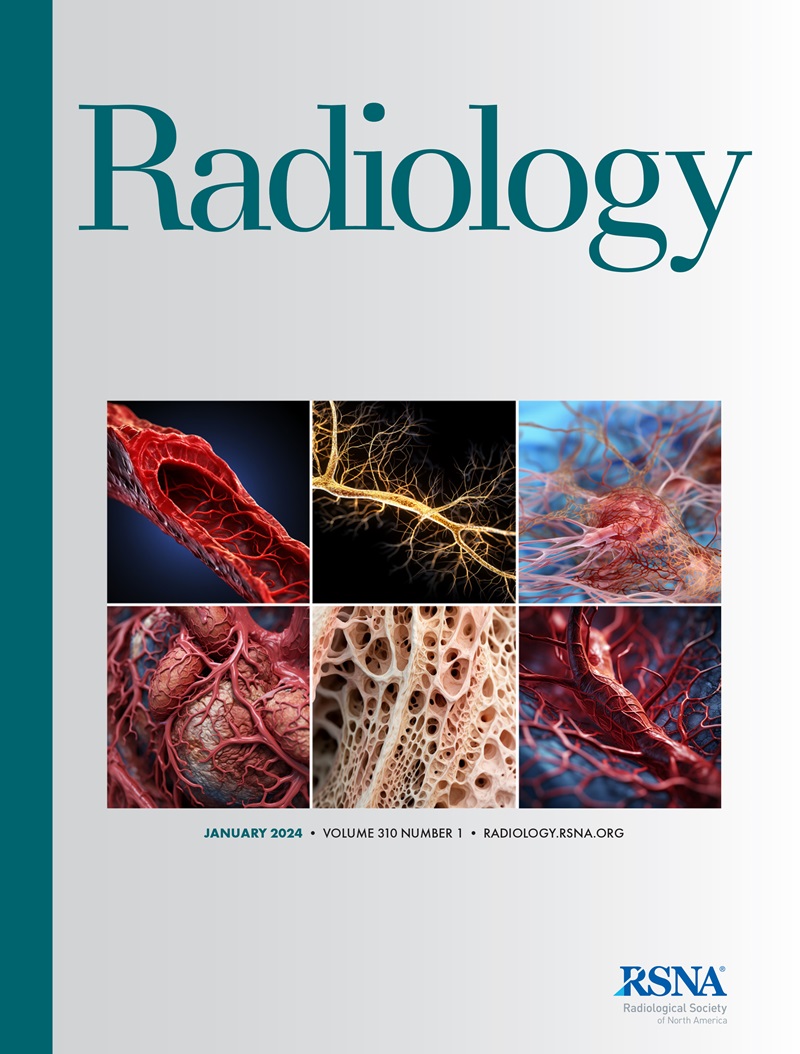求助PDF
{"title":"自动全面 CT 评估糖尿病及相关心脏代谢疾病的风险。","authors":"Yoosoo Chang, Soon Ho Yoon, Ria Kwon, Jeonggyu Kang, Young Hwan Kim, Jong-Min Kim, Han-Jae Chung, JunHyeok Choi, Hyun-Suk Jung, Ga-Young Lim, Jiin Ahn, Sarah H Wild, Christopher D Byrne, Seungho Ryu","doi":"10.1148/radiol.233410","DOIUrl":null,"url":null,"abstract":"<p><p>Background CT performed for various clinical indications has the potential to predict cardiometabolic diseases. However, the predictive ability of individual CT parameters remains underexplored. Purpose To evaluate the ability of automated CT-derived markers to predict diabetes and associated cardiometabolic comorbidities. Materials and Methods This retrospective study included Korean adults (age ≥ 25 years) who underwent health screening with fluorine 18 fluorodeoxyglucose PET/CT between January 2012 and December 2015. Fully automated CT markers included visceral and subcutaneous fat, muscle, bone density, liver fat, all normalized to height (in meters squared), and aortic calcification. Predictive performance was assessed with area under the receiver operating characteristic curve (AUC) and Harrell C-index in the cross-sectional and survival analyses, respectively. Results The cross-sectional and cohort analyses included 32166 (mean age, 45 years ± 6 [SD], 28833 men) and 27 298 adults (mean age, 44 years ± 5 [SD], 24 820 men), respectively. Diabetes prevalence and incidence was 6% at baseline and 9% during the 7.3-year median follow-up, respectively. Visceral fat index showed the highest predictive performance for prevalent and incident diabetes, yielding AUC of 0.70 (95% CI: 0.68, 0.71) for men and 0.82 (95% CI: 0.78, 0.85) for women and C-index of 0.68 (95% CI: 0.67, 0.69) for men and 0.82 (95% CI: 0.77, 0.86) for women, respectively. Combining visceral fat, muscle area, liver fat fraction, and aortic calcification improved predictive performance, yielding C-indexes of 0.69 (95% CI: 0.68, 0.71) for men and 0.83 (95% CI: 0.78, 0.87) for women. The AUC for visceral fat index in identifying metabolic syndrome was 0.81 (95% CI: 0.80, 0.81) for men and 0.90 (95% CI: 0.88, 0.91) for women. CT-derived markers also identified US-diagnosed fatty liver, coronary artery calcium scores greater than 100, sarcopenia, and osteoporosis, with AUCs ranging from 0.80 to 0.95. Conclusion Automated multiorgan CT analysis identified individuals at high risk of diabetes and other cardiometabolic comorbidities. © RSNA, 2024 <i>Supplemental material is available for this article.</i> See also the editorial by Pickhardt in this issue.</p>","PeriodicalId":20896,"journal":{"name":"Radiology","volume":null,"pages":null},"PeriodicalIF":12.1000,"publicationDate":"2024-08-01","publicationTypes":"Journal Article","fieldsOfStudy":null,"isOpenAccess":false,"openAccessPdf":"","citationCount":"0","resultStr":"{\"title\":\"Automated Comprehensive CT Assessment of the Risk of Diabetes and Associated Cardiometabolic Conditions.\",\"authors\":\"Yoosoo Chang, Soon Ho Yoon, Ria Kwon, Jeonggyu Kang, Young Hwan Kim, Jong-Min Kim, Han-Jae Chung, JunHyeok Choi, Hyun-Suk Jung, Ga-Young Lim, Jiin Ahn, Sarah H Wild, Christopher D Byrne, Seungho Ryu\",\"doi\":\"10.1148/radiol.233410\",\"DOIUrl\":null,\"url\":null,\"abstract\":\"<p><p>Background CT performed for various clinical indications has the potential to predict cardiometabolic diseases. However, the predictive ability of individual CT parameters remains underexplored. Purpose To evaluate the ability of automated CT-derived markers to predict diabetes and associated cardiometabolic comorbidities. Materials and Methods This retrospective study included Korean adults (age ≥ 25 years) who underwent health screening with fluorine 18 fluorodeoxyglucose PET/CT between January 2012 and December 2015. Fully automated CT markers included visceral and subcutaneous fat, muscle, bone density, liver fat, all normalized to height (in meters squared), and aortic calcification. Predictive performance was assessed with area under the receiver operating characteristic curve (AUC) and Harrell C-index in the cross-sectional and survival analyses, respectively. Results The cross-sectional and cohort analyses included 32166 (mean age, 45 years ± 6 [SD], 28833 men) and 27 298 adults (mean age, 44 years ± 5 [SD], 24 820 men), respectively. Diabetes prevalence and incidence was 6% at baseline and 9% during the 7.3-year median follow-up, respectively. Visceral fat index showed the highest predictive performance for prevalent and incident diabetes, yielding AUC of 0.70 (95% CI: 0.68, 0.71) for men and 0.82 (95% CI: 0.78, 0.85) for women and C-index of 0.68 (95% CI: 0.67, 0.69) for men and 0.82 (95% CI: 0.77, 0.86) for women, respectively. Combining visceral fat, muscle area, liver fat fraction, and aortic calcification improved predictive performance, yielding C-indexes of 0.69 (95% CI: 0.68, 0.71) for men and 0.83 (95% CI: 0.78, 0.87) for women. The AUC for visceral fat index in identifying metabolic syndrome was 0.81 (95% CI: 0.80, 0.81) for men and 0.90 (95% CI: 0.88, 0.91) for women. CT-derived markers also identified US-diagnosed fatty liver, coronary artery calcium scores greater than 100, sarcopenia, and osteoporosis, with AUCs ranging from 0.80 to 0.95. Conclusion Automated multiorgan CT analysis identified individuals at high risk of diabetes and other cardiometabolic comorbidities. © RSNA, 2024 <i>Supplemental material is available for this article.</i> See also the editorial by Pickhardt in this issue.</p>\",\"PeriodicalId\":20896,\"journal\":{\"name\":\"Radiology\",\"volume\":null,\"pages\":null},\"PeriodicalIF\":12.1000,\"publicationDate\":\"2024-08-01\",\"publicationTypes\":\"Journal Article\",\"fieldsOfStudy\":null,\"isOpenAccess\":false,\"openAccessPdf\":\"\",\"citationCount\":\"0\",\"resultStr\":null,\"platform\":\"Semanticscholar\",\"paperid\":null,\"PeriodicalName\":\"Radiology\",\"FirstCategoryId\":\"3\",\"ListUrlMain\":\"https://doi.org/10.1148/radiol.233410\",\"RegionNum\":1,\"RegionCategory\":\"医学\",\"ArticlePicture\":[],\"TitleCN\":null,\"AbstractTextCN\":null,\"PMCID\":null,\"EPubDate\":\"\",\"PubModel\":\"\",\"JCR\":\"Q1\",\"JCRName\":\"RADIOLOGY, NUCLEAR MEDICINE & MEDICAL IMAGING\",\"Score\":null,\"Total\":0}","platform":"Semanticscholar","paperid":null,"PeriodicalName":"Radiology","FirstCategoryId":"3","ListUrlMain":"https://doi.org/10.1148/radiol.233410","RegionNum":1,"RegionCategory":"医学","ArticlePicture":[],"TitleCN":null,"AbstractTextCN":null,"PMCID":null,"EPubDate":"","PubModel":"","JCR":"Q1","JCRName":"RADIOLOGY, NUCLEAR MEDICINE & MEDICAL IMAGING","Score":null,"Total":0}
引用次数: 0
引用
批量引用


